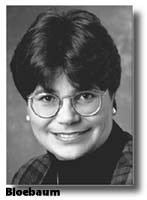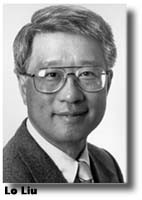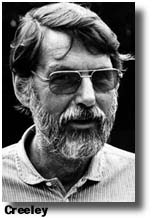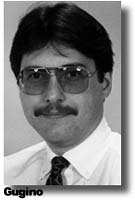| VOLUME 30, NUMBER 1 | THURSDAY, AUGUST 27, 1998 |
Briefly
Engineering appoints two new chairs
The School of Engineering and Applied Sciences has announced the appointments
of Christina L. Bloebaum as the chair of the Department of Mechanical and
Aerospace Engineering and Pao Lo Liu as chair of the Department of Electrical
Engineering.
 Bloebaum conducts research in multidisciplinary design
optimization, the field of engineering concerned with making large-scale
design more efficient and less costly.
Bloebaum conducts research in multidisciplinary design
optimization, the field of engineering concerned with making large-scale
design more efficient and less costly.
In 1995, she was named a Presidential Faculty Fellow, which recognizes the scholarly activities of the nation's outstanding science and engineering faculty members.
Bloebaum has earned the SUNY Chancellor's Award for Excellence in Teaching,
a University  Teaching Fellowship from UB and the Riefler
Award, which honors outstanding junior faculty in the School of Engineering
and Applied Sciences.
Teaching Fellowship from UB and the Riefler
Award, which honors outstanding junior faculty in the School of Engineering
and Applied Sciences.
Liu conducts research on photonic materials and devices, specifically computer-aided design tools and ultra-high-speed switching phenomena.
Recently, in collaboration with scientists in the Naval Research Laboratory, he demonstrated an optical signal processing system that can dynamically control the phase-array antenna.
In 1985, he was a recipient of the National Science Founda-tion's Presidential
Young Investigator Award.
Records and CDs by the thousands will go on sale at the final Vinyl and CD Madness, to be held by WBFO-88.7FM, UB's National Public Radio affiliate, on Saturday and Sunday.
WBFO listeners have provided the albums and CDs for the sale, which will benefit the station. The event will be held in Allen Hall on the South Campus.
WBFO members can preview and purchase items from 9-11 a.m. on Saturday.
The general public will be admitted from 11 a.m. to 5 p.m. on Saturday and
from 11 a.m. to 4 p.m. Sunday.
Sheffer to address Emeritus Center
John B. Sheffer II, director of the Institute for Local Governance and Regional Growth, will be the speaker for the Emeritus Center meeting at 2 p.m. Sept. 8 in the South Lounge of Goodyear Hall. He will speak on "The Challenge of Regional Excellence."
Jack Baker will preside at the session. A board of directors meeting
will be held at 1 p.m.
Levine is president-elect of APA law society
Murray Levine, SUNY Distinguished Service Professor in the Department of Psychology, has been named president-elect of the American Psychology Law Society, a division of the American Psychological Association (APA).
A faculty member since 1968, Levine is director of the Research Center for Children and Youth and adjunct professor of law.
In 1997, he received the Seymour B. Sarason Award for Community Research and Action from the APA in recognition of career accomplishments.
Named to the U.S. Advisory Board on Child Abuse and Neglect in 1994, Levine has written extensively on legal issues of child abuse and neglect and has served as a member of APA's Working Group on Legal and Policy Issues in Child Abuse and Neglect.
His book, "Helping Children: A Social History," is considered
a classic study of the evolution of child welfare services in the U.S.
Levy to be honored by American College of Clinical Pharmacology
Gerhard Levy, UB Distinguished Professor Emeritus in the Department of Pharmaceutics, will receive the 1998 Distinguished Investigator Award from the American College of Clinical Pharmacology at the College's annual meeting in Toronto on Sept. 24. He will address members of the College on Predicting Pharmacodynamic Drug-Disease Interactions.
Levy who retired in 1995, remains on active status. The author of more
than 500 scholarly publications, he is internationally known for his research
in pharmacokinetics, kinetics of drug action and biopharmaceutics.
Townsend named associate VP, special assistant to president
Nelson E. Townsend, who has been on medical leave since experiencing a heart attack in April, will assume new duties when he returns to work later this month.
Townsend, who joined UB in 1987 as director of the Division of Athletics, will assume the duties of associate vice president for student affairs and special assistant to UB President William R. Greiner.
Bob Arkeilpane, who has served as interim athletics director since April, will continue in that position.
UB will commence a national search during the 1998-99 academic year to
identify a new athletics director.
Creeley to host collaborative performance Sept. 5
Robert Creeley, Samuel P. Capen Chair in Poetry and the Humanities, is one of the most influential and innovative American poets of the last half-century. He also is one of the best known, principally for his many books of poetry and essays, and his strong connections with some of the greatest writers of our day-Charles Olsen, Robert Duncan,
 Allen Ginsberg
and Ed Dorn among many others.
Allen Ginsberg
and Ed Dorn among many others.
Less well known are the collaborations that marry his modernist verse to the visual art of Jim Dine, for instance, and to the music of exceptional contemporary composers and performers. Creeley's cooperative musical ventures have involved brilliant improvisational jazz artists-pianist Steve Kuhn, saxophonist Steve Lacy, bass guitarist Steve Swallow, as well as younger avant garde artists like Mercury Rev. Several have been recorded on CD and have received critical applause.
On Sept. 5 at 8 p.m., the literary series, "Wednesdays at 4 Plus," will open its 1998-99 season in Hallwalls Contemporary Arts Center with just such a collaborative performance.
Creeley will host a program in which he will perform his poetry with the music of a first-time trio composed of bass great Steve Swallow; avant guitar's "King Snake," David Torn, and Buffalo's own "different drummer," Chris Massey, who has been performing in Europe.
For additional information on Creeley, check the Internet at http://www.levity.com/corduroy/creeley.html
or type "robert creeley" into a search engine for links to more
than 400 sites. For information on Steve Swallow, go to http://www2.pcom.net/rminer/_home_notes.html
or http://www2.pcom.net/rminer/steve_interviews
Ryan recognized for creating listserv to aid disabled
Daniel Ryan, director of the Office of Career Planning and Placement, has received the 1998 Professional Recognition Award from the Association for Higher Education and Disability (AHEAD). The award distinguishes AHEAD members who use an innovative idea or implement a project that provides a service to help students with disabilities.
Ryan was recognized for establishing and maintaining the Disabled Student Services in Higher Education Listserv. The listserv, which he initiated in 1993, has become a critical resource to practitioners in the field and a place for providers of services to students with disabilities to bring their technical questions and concerns. Subscribers can receive electronically expert advice and opinions from other professionals in the field.
A member of the National Association of Student Personnel Administrators, Ryan was named an Outstanding New Professional by the organization in 1992. His other professional affiliations include the National Career Development Association, the American Association on Higher Education and the Western New York Consortium of College Disability Advocates.
Ryan was recognized in "Who's Who in America" in 1998, "Who's Who in the East" in 1996 and "Who's Who in American Education" in 1994.
He received a doctorate in higher education administration from UB and
master's and baccalaureate degrees from Canisius College.
Financial aid information now available on BIRD
The Financial Aid Office now is offering its services through the Billing, Inquiry, Records and Drop/Add (BIRD) touch-tone system.
Through BIRD, students will be able to review their financial-aid application status, find out what information they still need to provide, review their financial-aid packages and the kinds of aid they have been offered, and accept and decline student loans.
To access, student can call BIRD at 645-7800 and select the Financial Aid option.
Additional information about financial aid also is available on the Web
at http://wings. buffalo.edu/services/fin-aid
UB community asked to update E-Directory information
The university community is being asked to update the information that is listed in the UB E-Directory, the online directory of faculty, staff and students.
The directory, which can be accessed at http://ldap. buffalo.edu, is a comprehensive and searchable electronic source of information that includes names, titles, campus addresses, phone numbers and e-mail addresses.
Updating information in the directory is easy. After logging in, click
on "update" to bring up the form that allows users to update personal
information and insert their preferred e-mail address. A UNIX password is
needed to make changes; Don't know your password? Have it reset by calling
645-3540. Instructions for updating information are available online. If
you need more help, call the CIT help desk at 645-3540.
Employing 'evolution' to develop new drug leads
Just as conventional libraries are only as good as the books on their shelves, chemical libraries synthesized by pharmaceutical scientists are only as useful as the new compounds they generate. A drug-discovery method being developed by UB researchers may be able to turn those chemical libraries, arrays of compounds synthesized in the lab, into molecular "habitats" where only the most desirable drug candidates survive. Based on the application of Darwinian principles of evolution to a chemical system, the method is designed to endow compounds in chemical libraries with the ability to evolve into the best potential drug candidate for a particular molecular target.
Called dynamic combinatorial chemistry, the new method could mean major cost savings for pharmaceutical companies because it has the potential to identify numerous promising drug leads in days, as compared to months or years using current techniques.
It was described in a presentation by Alexey V. Eliseev, assistant professor of medicinal chemistry, at the 39th annual UB Medicinal Chemistry Symposium. "In (traditional) combinatorial chemistry, the goal is to produce many possible combinations and then screen the compounds individually," said Eliseev. "In our method we combine the steps."
The UB method works by using molecular recognition-the ability of molecules
to bind to a target-to simultaneously form and screen mixtures of many chemicals
for the best ones.
Sperm abnomalities linked to low pregnancy rate
Fertility researchers in the School of Medicine and Biomedical Sciences have found a link between two sperm abnormalities-premature chromosomal decondensation and premature acrosome reaction-and low pregnancy rates. The abnomalities, which are overlooked in a standard semen analysis, had never been linked to low pregnancy rates, said Lani J. Burkman, assistant professor of gynecology and obstetrics, and urology, and head of the Andrology Section in the Department of Gynecology-Obstetrics.
By analyzing hundreds of semen samples and comparing them with subsequent pregnancies in the couples studied, Burkman and colleagues determined that samples showing more than 14 percent premature chromosomal decondensation or more than 7 percent premature acrosome reactions had only a slim chance of leading to a pregnancy. Burkman presented study results in San Diego, Calif., at a meeting of the American Urology Association.
The acrosome is an enzyme-filled cap covering half the sperm head. Just before fertilization, enzymes from the acrosome, activated at the proper time, soften the egg's covering, allowing the sperm head to fertilize the egg. If the enzymes are released too soon, a process called premature acrosome reaction, the sperm is rendered useless.
Premature chromosomal decondensation refers to the untimely unraveling of the sperm's genetic cargo. If this begins before the sperm has penetrated the egg, the sperm head swells and fertilization becomes impossible. "In our study, when pregnancy occurred, we knew that the partner's sperm were capable of fertilizing the egg," Burkman said. "When pregnancy did not occur, the possibility existed that the sperm failed at one or more points in the fertilization process."
Researchers analyzed semen samples from 250 patients. Each sperm slide
was scored for percentage of sperm showing the premature acrosome reaction
or evidence of chromosomal decondensation. These scores were correlated
with pregnancy results. Results showed a very low incidence of chromosomal
decondensation or acrosome reaction in the natural pregnancy group; in the
no-pregnancy group, rates for both errors were significantly higher.
Warning sign indicates need to test for fetal risk condition
Physicians traditionally have looked for the presence of at least three clinical signs of chorioamnionitis before ordering a test for the condition, an inflammation of the fetal membranes that is a risk factor for fetal death. Researchers at UB are recommending that the presence of only
 one is reason
to conduct a diagnostic test. Research results were reported by Lawrence
J. Gugino, associate professor of gynecology and obstetrics and lead author,
at the 46th annual clinical meeting of the American College of Obstetricians
and Gynecologists.
one is reason
to conduct a diagnostic test. Research results were reported by Lawrence
J. Gugino, associate professor of gynecology and obstetrics and lead author,
at the 46th annual clinical meeting of the American College of Obstetricians
and Gynecologists.
Chorioamnionitis is associated with premature rupture of the fetal membrane and premature delivery. Gugino and colleagues reviewed records of 804 perinatal deaths that occurred in Children's Hospital of Buffalo between 1988 and 1996. Chorioamnionitis was found to be present in 243, or about one-third of these cases.
Traditionally, three clinical indicators, including maternal fever, elevated
white cell count, uterine tenderness, foul-smelling discharge and increased
fetal heartbeat, were considered necessary to justify screening for chorioamnionitis.
By comparing patient records during the pregnancy with results of the laboratory
analysis of placental tissue after the fetal or infant death, Gugino and
colleagues found that if only one of these symptoms is present, chorioamnionitis
should be suspected and patients should be tested.
Front Page | Top Stories | Q&A |
Briefly | Mail
Events | Obituary
| Electronic Highways | Focus on Research
Current Issue | Comments? | Archives | Search
UB Home | UB News Services | UB Today